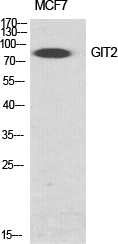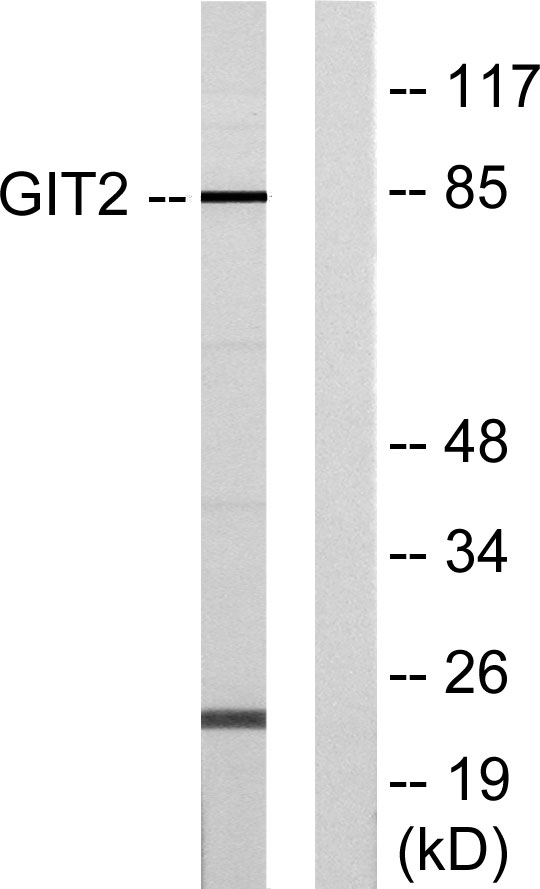GIT2 Polyclonal Antibody
- Catalog No.:YT1909
- Applications:WB;IHC;IF;ELISA
- Reactivity:Human;Mouse;Rat
- Target:
- GIT2
- Fields:
- >>Endocytosis;>>Yersinia infection
- Gene Name:
- GIT2
- Protein Name:
- ARF GTPase-activating protein GIT2
- Human Gene Id:
- 9815
- Human Swiss Prot No:
- Q14161
- Mouse Gene Id:
- 26431
- Mouse Swiss Prot No:
- Q9JLQ2
- Immunogen:
- The antiserum was produced against synthesized peptide derived from human GIT2. AA range:361-410
- Specificity:
- GIT2 Polyclonal Antibody detects endogenous levels of GIT2 protein.
- Formulation:
- Liquid in PBS containing 50% glycerol, 0.5% BSA and 0.02% sodium azide.
- Source:
- Polyclonal, Rabbit,IgG
- Dilution:
- WB 1:500 - 1:2000. ELISA: 1:10000.. IF 1:50-200
- Purification:
- The antibody was affinity-purified from rabbit antiserum by affinity-chromatography using epitope-specific immunogen.
- Concentration:
- 1 mg/ml
- Storage Stability:
- -15°C to -25°C/1 year(Do not lower than -25°C)
- Other Name:
- GIT2;KIAA0148;ARF GTPase-activating protein GIT2;ARF GAP GIT2;Cool-interacting tyrosine-phosphorylated protein 2;CAT-2;CAT2;G protein-coupled receptor kinase-interactor 2;GRK-interacting protein 2
- Observed Band(KD):
- 84kD
- Background:
- This gene encodes a member of the GIT protein family, which interact with G protein-coupled receptor kinases and possess ADP-ribosylation factor (ARF) GTPase-activating protein (GAP) activity. GIT proteins traffic between cytoplasmic complexes, focal adhesions, and the cell periphery, and interact with Pak interacting exchange factor beta (PIX) to form large oligomeric complexes that transiently recruit other proteins. GIT proteins regulate cytoskeletal dynamics and participate in receptor internalization and membrane trafficking. This gene has been shown to repress lamellipodial extension and focal adhesion turnover, and is thought to regulate cell motility. This gene undergoes extensive alternative splicing to generate multiple isoforms, but the full-length nature of some of these variants has not been determined. The various isoforms have functional differences, with respect to ARF GAP activity and to G
- Function:
- alternative products:Additional isoforms seem to exist,function:GTPase-activating protein for the ADP ribosylation factor family.,similarity:Contains 1 Arf-GAP domain.,similarity:Contains 3 ANK repeats.,subunit:Interacts with TGFB1I1 (By similarity). Interacts with G protein-coupled receptor kinases. Associates with paxillin. Also interacts with PIX exchange factors.,
- Subcellular Location:
- nucleoplasm,focal adhesion,
- Expression:
- B-cell,Bone marrow,Cerebellum,Dermoid cancer,Epithelium,Skin,T-cell,
- June 19-2018
- WESTERN IMMUNOBLOTTING PROTOCOL
- June 19-2018
- IMMUNOHISTOCHEMISTRY-PARAFFIN PROTOCOL
- June 19-2018
- IMMUNOFLUORESCENCE PROTOCOL
- September 08-2020
- FLOW-CYTOMEYRT-PROTOCOL
- May 20-2022
- Cell-Based ELISA│解您多样本WB检测之困扰
- July 13-2018
- CELL-BASED-ELISA-PROTOCOL-FOR-ACETYL-PROTEIN
- July 13-2018
- CELL-BASED-ELISA-PROTOCOL-FOR-PHOSPHO-PROTEIN
- July 13-2018
- Antibody-FAQs
- Products Images

- Western Blot analysis of various cells using GIT2 Polyclonal Antibody diluted at 1:1000 cells nucleus extracted by Minute TM Cytoplasmic and Nuclear Fractionation kit (SC-003,Inventbiotech,MN,USA).
.jpg)
- Western Blot analysis of HepG2 cells using GIT2 Polyclonal Antibody diluted at 1:1000 cells nucleus extracted by Minute TM Cytoplasmic and Nuclear Fractionation kit (SC-003,Inventbiotech,MN,USA).

- Western blot analysis of lysates from HepG2 cells, using GIT2 Antibody. The lane on the right is blocked with the synthesized peptide.



